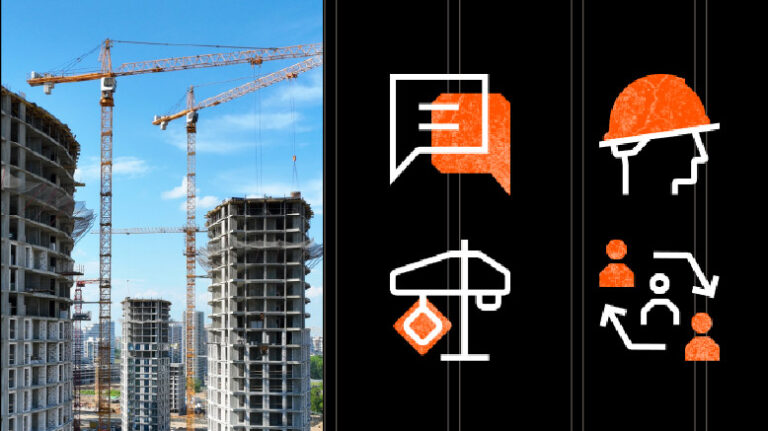— 9 min read
The 4 Pillars of Operational Excellence in Construction


Last Updated Jul 15, 2025

Brett King
Director of Industry Transformation, EMEA
9 articles
Brett King is a construction industry transformation leader with over 15 years' experience delivering major projects and driving operational excellence across the UK and EMEA. As Director of Industry Transformation at Procore, he helps clients tackle complex challenges—from regulatory compliance and digital adoption to data strategy, AI integration, and change management at scale. With a background in business improvement and tech implementation at leading contractors, Brett bridges site-level realities with strategic outcomes—translating vision into action. A regular speaker, workshop facilitator, and trusted advisor, he’s known for making the complex simple and the theoretical practical. When he’s not driving change in construction, he’s driving greens, chasing Strava segments, or finding the best thing on the menu.

James Hamilton
Writer & Producer
85 articles
James Hamilton is a writer based in Brooklyn, New York with experience in television, documentaries, journalism, comedy, and podcasts. His work has been featured on VICE TV and on The Moth. James was a writer and narrator for the show, VICE News Tonight, where he won an Emmy Award and was nominated for a Peabody Award.
Last Updated Jul 15, 2025

Operational excellence is achieved gradually. For most high-performing contractors and companies, success comes from entering into a cycle of consistently improving operational efficiency: make data-driven decisions, execute with commitment and precision, measure performance to get more data, then make even better decisions and repeat.
Even the brightest talent and shiniest tech will go to waste without a commitment to mindset, systems and consistency. Every member of the team must:
- Be clear on performance targets.
- Have the capacity for high performance, including tools, processes, knowledge and skills.
- Pursue the highest level of execution.
- Develop a culture of high performance that fosters continuous improvement, trust and accountability.
Those make up the four pillars of operational excellence in construction: clarity, capability, execution and culture. Let’s dive in.
Table of contents
1. Clarity
Performance goals should be specific and measurable, ambitious yet feasible and perhaps most importantly, staff and partners should know the exact goals they’re expected to achieve.
All teams want projects to make money and be completed on time, without defects and without safety or health incidents. But in order to actually achieve those things, everyone working on a project must know:
- What success looks like today
- The time, cost, quality and safety targets they are chasing
- How their performance will be measured
Tools & Tips
Dashboards and real-time reporting provide people with information about their performance. Dashboards might include data on benchmarks, defects, safety incidents, RFI response times or delays. This creates real-time visibility into how a project’s going. Field data can connect with project controls, helping leadership make faster, more informed decisions.
Clarity often includes benchmarks and smaller goals needed to achieve larger objectives. This helps people understand what goes into achieving ambitious goals and identify the exact points where a project slips.
Build clarity and goal setting into every part of the day, including:
- Reporting
- Debriefs
- Performance reviews
- Morning meetings
- Planning
- Communication
Most organizations have the same KPIs. Things like, ‘We want to finish on time,’ ‘We want to finish defect-free,’ and ‘We want to finish with no health and safety incidents.’ But when you scratch under the surface, effective organizations understand what those mean in terms of metrics.
At any given time, they have dashboards to go and see live reporting on, for example, exactly how many man hours they have without incidents. If you’re not recording that, how are you even going to know? You’re going to wait until there’s an accident and say, 'Oh, we failed.' When you have clear KPIs that you can report on, it drives that behavior.

Brett King
Director of Industry Transformation, EMEA
Procore Technologies
Challenges
Information overload is real. People can’t be expected to parse through sprawling datasets related to every KPI.
Defining success for any given day helps people prioritize the metrics they should be monitoring. Further, many dashboards allow for a “traffic light” effect, which is big-picture metrics will be green when on track, yellow when at risk and red when seriously off.
Once they see a KPI slipping, people can click through to see more detailed data to determine where the breakdown is occurring.
Connecting to Other Pillars
Clarity depends on a culture that promotes collaboration, transparency and trust. Without that, metrics can make people feel fear, shame or resentment. Organizations thrive when people view data as a tool to get better at what they do, as opposed to something that will be held against them.
2. Capability
In construction, lack of training, outdated systems or overloaded project managers is similar to asking the fastest runners in the world to race in flip-flops. In order to achieve excellence, people need the necessary tools, training, information and time to get there.
Capability comes from systems (CMS, document management software), tools (BIM, digital site diaries) and people development (training, mentoring, enablement).
Capability needs to be considered at every part of the construction process. Tasks should be realistically planned. Supply chains need to be vetted and accounted for. People need to have the right tools and, just as importantly, they need to know how to use them.
Tools & Tips
Standardize processes, such as templated workflows, embedded checklists, built-in guidance and early inspections to help support more consistent delivery, avoid mistakes and allow workers to focus on more important tasks.
One of the biggest challenges in the industry at the moment is an aging workforce. A huge amount of our workforce is going to retire and they’re going to take their knowledge with them. The trick with technology is, how do we get the knowledge from that person into our platforms?
Tools like construction management software allow for templated workflows, embedded checklists and built-in guidance that turn the platform into more than just a system; it becomes a training and enablement layer. This makes onboarding faster, supports consistent delivery and ensures that expertise isn’t locked in a few heads.
Brett King
Director of Industry Transformation, EMEA
Procore Technologies
Challenges
Training takes tim and tools take money. Assessing and building capability often takes front-loaded resources. However, when done deliberately, assessing and building capability now should help improve outcomes later.
For example, retraining team members in specific tasks, such as digital site diaries or defect management tools, can feel like a costly use of resources, but it can significantly decrease rework and delivery times.
Connecting to Other Pillars
The more detailed the KPIs and the metrics, the more helpful they become in identifying the exact breakdown in capability. It’s being able to move past “something went wrong,” and towards identifying is an issue occurred because of planning, manpower, tools, weather, or miscommunications.
3. Execution
Once goals are established and capability is ensured, it’s time to do the work. Execution isn’t about doing more – it’s about doing the right things, consistently. Perfectly planned schedules, systems and workflows still break down when tasks are missed, people don’t show up or lessons aren’t learned.
Execution, just like setting goals, isn’t about, “Just go do it.” Workers excel in execution when they understand exactly what’s expected of them, how they’ll be assessed and benchmarks along the way.
Pro Tip
To proactively manage quality on projects, establish a clear benchmark by thoroughly inspecting the initial installation with all relevant stakeholders, gaining their agreement on what "good" looks like. Build a comprehensive checklist based on this benchmark including potential pitfalls. Then, schedule frequent, targeted inspections throughout the project lifecycle. This approach allows you to identify and address any deviations or defects immediately at the point of inspection, rather than discovering them at the very end.
Tools & Tips
Give people numerous opportunities to understand how they’re doing and effective ways to do better. This might include early inspections, monthly performance reviews, action-based dashboards, subcontractor scoring or project health checks.
Construction management platforms can remove friction from completing regular tasks, such as RFIs, drawing updates, inspection and closeouts. Standardizing and automating workflows can decrease rework and delays, while letting team members focus on the best ways to get to project completion.
Tech and data help make execution visible, trackable and fixable. When slippage occurs, circle back on performance metrics to identify where a breakdown occurred.
Challenges
Some people prickle at the idea of being tracked or reflecting on their performance. Good culture helps overcome feelings of being micromanaged or wasting time. People need to understand what they’re working towards and how transparency, communication and accountability contribute to those goals and the culture of the workplace.
Connecting to Other Pillars
Execution is often where culture is built and tested. It’s when people see transparency, accountability and communication are tools towards outstanding performance. As people find success, they become even more invested and excited in creating a high-performing culture.
Stay updated on what’s happening in construction.
Subscribe to Blueprint, Procore’s free construction newsletter, to get content from industry experts delivered straight to your inbox.

4. Culture
Highly effective organizations move from reacting to problems and issues as they pop up, to proactively identifying problems and clearing the path to success. Culture is how they do that.
Culture is many things, but it might be easiest to describe as the things team members do when no one is watching. An effective culture conjures a sense of accountability for performance results and an urgency to surpass those targets. People show up on time, observe safety protocols, see data as a means to success, pursue proactive decision-making and value collaboration. High-performance culture means people have account without fear, pride without ego and work towards improving without excuses.
Tools & Tips
Culture is often about habits and systems. Celebrate consistent and outstanding performance, build feedback loops and link improvement to rewards and career progression.
Technology helps people engage with how their actions contribute to an organization’s culture. Tools like Procore’s observations, tasks and meetings foster transparency and the pursuit of continuous improvement.
Introduce a policy where project closeout includes teams documenting and sharing five key learnings. This shifts perspectives from moving past issues, or even hiding them, to reflecting on and solving them proactively.
I worked in an organization that put a monetized value on its metrics. For example, we said we want to finish without any accidents, so we will give you money for having zero accidents. But because it was monetized, the culture it drove caused people to stop reporting accidents. They thought 'If we don’t report accidents, it will always look like zero.'
It’s a great metric, but do not monetize that metric, because you drive a culture of non-reporting. In the end, we said, 'We want you to record all your incidents, no matter how big or small.' Then, the more observations they made, the higher up the chart they scored.
Brett King
Director of Industry Transformation, EMEA
Procore Technologies
Challenges
Organizational culture exists, whether it’s acknowledged or not. When people show up late, documents aren’t organized and delays are expected on every project, that’s culture too. Building a positive culture of high performance requires deliberate planning and collaboration carried out over a long time.
Connecting to Other Pillars
Culture drives the other three pillars. How people engage with goals, metrics, data, training and day-to-day work is heavily influenced by the culture of their team.
The Role of Technology & The 4 Pillars
Technology should help establish and maintain clarity, capacity, excellence in execution and a high-performing culture.
Tech can be a vehicle to success, but it requires people to get there. Introducing tech should be done when it helps teams improve the work they do. It should be a deliberate process that explains why a new tool has been adopted, its benefit and how its value will be assessed over time.
Take time to hear concerns and answer questions about new tools. More often than not, people have valid questions and concerns that, when addressed head-on, actually lead to a more effective adoption process.
Was this article helpful?
Thank you for your submission.
0%
0%
You voted that this article was . Was this a mistake? If so, change your vote
Scroll less, learn more about construction.
Subscribe to The Blueprint, Procore’s construction newsletter, to get content from industry experts delivered straight to your inbox.
By clicking this button, you agree to our Privacy Notice and Terms of Service.
Thank you!
You’re signed up to receive The Blueprint newsletter from Procore. You can unsubscribe at any time.
Categories:
Written by

Brett King
Director of Industry Transformation, EMEA | Procore Technologies
9 articles
Brett King is a construction industry transformation leader with over 15 years' experience delivering major projects and driving operational excellence across the UK and EMEA. As Director of Industry Transformation at Procore, he helps clients tackle complex challenges—from regulatory compliance and digital adoption to data strategy, AI integration, and change management at scale. With a background in business improvement and tech implementation at leading contractors, Brett bridges site-level realities with strategic outcomes—translating vision into action. A regular speaker, workshop facilitator, and trusted advisor, he’s known for making the complex simple and the theoretical practical. When he’s not driving change in construction, he’s driving greens, chasing Strava segments, or finding the best thing on the menu.
View profile
James Hamilton
Writer & Producer
85 articles
James Hamilton is a writer based in Brooklyn, New York with experience in television, documentaries, journalism, comedy, and podcasts. His work has been featured on VICE TV and on The Moth. James was a writer and narrator for the show, VICE News Tonight, where he won an Emmy Award and was nominated for a Peabody Award.
View profileExplore more helpful resources

Transforming Construction Project Management With Predictive Analytics
Construction leaders who can correctly identify project challenges before they arise can more easily sidestep them. This saves time, money and significant delays. Predictive analytics attempts to forecast future outcomes...

Capital Project Management: A Quick Guide for Construction Pros
With aging infrastructure and new technology needs, capital projects will remain a high priority for communities around the world in the coming years. Effectively managing capital construction projects is necessary...

Avoiding The App Trap: Overcome Financial Silos to Connect Field & Office
For general contractors working on razor-thin margins, rework and project delays are more than simple inefficiencies — they are major threats to the bottom line. For years, GCs have attempted...

Profit from Predictability: Construction Software as a Business Strategy
For general contractors, managing complex, multi-million-dollar projects, every project phase — from planning and budgeting to on-site execution — is an opportunity to lose time and money. Construction software is...
Free Tools
Calculators
Use our calculators to estimate the cost of construction materials for your next project.
Templates
Find a template to help you with your construction project tasks.
Material Price Tracker
Get the latest U.S. retail prices and view historical trends for common building materials.
Glossary
Explore key terms and phrases used in the industry.
